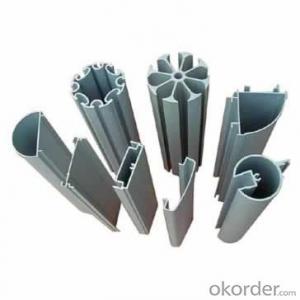aluminum profiles with different surface
- Loading Port:
- China Main Port
- Payment Terms:
- TT OR LC
- Min Order Qty:
- -
- Supply Capability:
- -
OKorder Service Pledge
Quality Product, Order Online Tracking, Timely Delivery
OKorder Financial Service
Credit Rating, Credit Services, Credit Purchasing
You Might Also Like
Material | Alloy 6063,6061,6005or according to customer’s choice |
Temper | T3, T4, T5, T6 |
Surface | Anodize, electrophoresis, powder coating, PVDF coating, wood grain painting, matted, etc. |
Color | Any colour based on Standard Germany RAL Mark |
Length | Coating 6.5 meters, Anodizing 6.5 meters, Mill finish 5 meters |
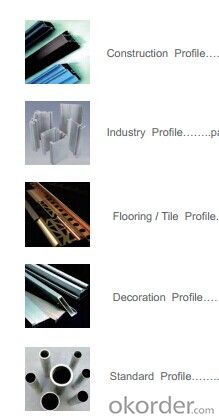

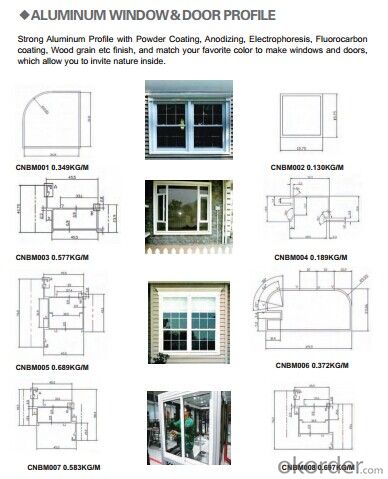
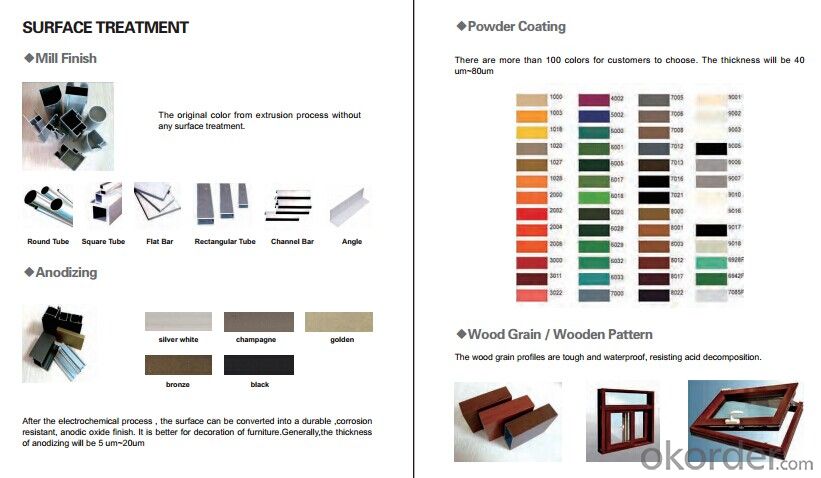
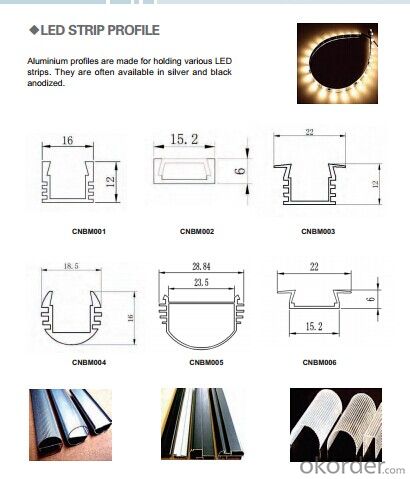
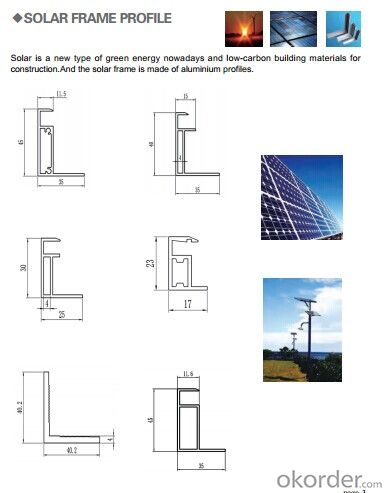
- Q:Can aluminum profiles be used for curtain walls?
- Yes, aluminum profiles can be used for curtain walls. In fact, aluminum is one of the most commonly used materials for curtain wall systems due to its excellent combination of strength, durability, and lightweight nature. Aluminum profiles offer various advantages for curtain walls, including flexibility in design, ease of installation, and low maintenance requirements. Additionally, aluminum is highly resistant to corrosion, which is crucial for exterior applications. The versatility of aluminum profiles allows architects and designers to create aesthetically pleasing curtain wall systems that can withstand environmental factors and provide structural support for buildings.
- Q:Are aluminum profiles suitable for use in the mining industry?
- Yes, aluminum profiles are suitable for use in the mining industry. Aluminum is lightweight, corrosion-resistant, and durable, making it ideal for various applications in mining equipment and infrastructure. It offers strength and stability while being easy to transport and install. Additionally, aluminum profiles can withstand harsh environmental conditions and are resistant to chemicals commonly found in mining operations.
- Q:Are aluminum profiles suitable for use in automotive suspension systems?
- Yes, aluminum profiles are suitable for use in automotive suspension systems. Aluminum is lightweight, yet strong and durable, making it an ideal material for reducing the overall weight of the suspension system. The use of aluminum profiles can improve the handling, fuel efficiency, and performance of the vehicle. Additionally, aluminum profiles offer excellent corrosion resistance, contributing to the longevity of the suspension system.
- Q:Are aluminum profiles suitable for use in the marine industry?
- Yes, aluminum profiles are suitable for use in the marine industry. Aluminum is a lightweight, durable, and corrosion-resistant material, making it ideal for various marine applications, including boat building, shipbuilding, and offshore structures. Its high strength-to-weight ratio allows for efficient and reliable construction, while its resistance to saltwater and harsh environmental conditions ensures longevity. Additionally, aluminum profiles can be easily fabricated, providing flexibility in design and customization. Overall, aluminum profiles offer numerous advantages that make them well-suited for use in the marine industry.
- Q:How about the price of aluminum profile?
- Usually calculated by weight, or by weight according to the length of each metre.
- Q:What is the relationship between aluminum alloy and aluminum alloy?
- Two, according to the alloy can be divided into 1024 categories: a 2011, 6063, 6061, 6082, 7075 grade aluminum alloy, which is the 6 most common. Grades are different in various metal components ratio is not the same, in addition to the commonly used aluminum doors and windows In addition to such as the 60 series, 70 series, 80 series, 90 series, curtain wall series aluminum profile, aluminum industry has no clear distinction model, most manufacturers are in accordance with the actual drawings processing customer. Three, according to the requirement of surface treatment: 1. anodized aluminum 2. Electrocoat aluminum 3. aluminum powder coating 4. transfer grain aluminum 5. aluminum polishing (divided into mechanical polishing and chemical polishing of two, the chemical polishing of the highest cost, the price is the most expensive)
- Q:How are aluminum profiles insulated?
- Aluminum profiles can be insulated in several ways to enhance their thermal performance. One common method is to incorporate a thermal break within the profile design. This involves the insertion of a non-conductive material, such as polyamide or polyurethane, between the inner and outer parts of the profile. This thermal break helps to minimize heat transfer between the interior and exterior of a building, thus improving energy efficiency. Another approach to insulating aluminum profiles is through the application of insulating materials, such as foam or rubber, on the interior or exterior surfaces of the profile. These materials act as barriers to reduce heat transfer and provide additional insulation. Furthermore, aluminum profiles can also be fitted with insulating gaskets or seals. These gaskets are typically made of rubber or other insulating materials and are positioned between the profile and the glazing, creating a thermal barrier and preventing heat loss or gain. Overall, the insulation of aluminum profiles involves incorporating thermal breaks, applying insulating materials, or using gaskets to minimize heat transfer and improve the energy efficiency of buildings.
- Q:What are the different surface protection options available for aluminum profiles?
- There are several surface protection options available for aluminum profiles, including anodizing, powder coating, painting, and laminate coating. Anodizing is a process that creates a durable and corrosion-resistant layer on the surface of the aluminum. Powder coating involves applying a dry powder to the surface, which is then heated to form a protective layer. Painting involves applying liquid paint to the surface, providing both protection and aesthetic appeal. Laminate coating involves applying a thin layer of protective material, such as plastic or wood, to the surface of the aluminum. Each option offers different benefits and is suitable for various applications.
- Q:How do aluminum profiles contribute to lightweight construction?
- Aluminum profiles play a significant role in lightweight construction due to their inherent properties and versatile applications. Firstly, aluminum is a lightweight material itself, with a density that is about one-third of steel. This means that using aluminum profiles instead of heavier materials like steel or concrete helps to reduce the overall weight of the structure or product. The lightweight nature of aluminum profiles brings several advantages to the construction industry. One of the key benefits is that it allows for easier handling and installation, reducing the need for heavy machinery and labor-intensive processes. This not only improves the efficiency of construction projects but also reduces costs. Moreover, the use of aluminum profiles in lightweight construction contributes to energy efficiency. Aluminum is an excellent conductor of heat and electricity, which means it can effectively dissipate heat and reduce energy consumption in buildings. This property is particularly beneficial for constructing energy-efficient buildings and helps to meet sustainability goals. Another aspect where aluminum profiles contribute to lightweight construction is their exceptional strength-to-weight ratio. Despite being lightweight, aluminum profiles possess high tensile strength, which makes them highly durable and capable of withstanding various loads and stresses. This characteristic allows for the design of strong and stable structures while minimizing material usage. Additionally, aluminum profiles offer design flexibility and versatility. They can be extruded into various shapes and sizes, enabling architects and designers to create complex and innovative structures. The ability to customize profiles according to specific project requirements enhances the architectural possibilities in lightweight construction. Furthermore, aluminum profiles are corrosion-resistant, which significantly extends their lifespan and reduces maintenance costs. This makes them suitable for applications in different climates and environments, including coastal regions where saltwater corrosion is prevalent. In summary, aluminum profiles contribute to lightweight construction by reducing the overall weight of structures, improving energy efficiency, providing strength and durability, offering design flexibility, and ensuring resistance to corrosion. These factors make aluminum profiles a preferred choice in a wide range of construction projects, from residential buildings to large-scale infrastructure.
- Q:What are the different packaging options for aluminum profiles?
- Some of the different packaging options for aluminum profiles include bundles or packs wrapped in plastic or stretch film, wooden crates or pallets, cardboard boxes, and custom-designed packaging solutions for specific profiles or customer requirements.
1. Manufacturer Overview |
|
|---|---|
| Location | |
| Year Established | |
| Annual Output Value | |
| Main Markets | |
| Company Certifications | |
2. Manufacturer Certificates |
|
|---|---|
| a) Certification Name | |
| Range | |
| Reference | |
| Validity Period | |
3. Manufacturer Capability |
|
|---|---|
| a)Trade Capacity | |
| Nearest Port | |
| Export Percentage | |
| No.of Employees in Trade Department | |
| Language Spoken: | |
| b)Factory Information | |
| Factory Size: | |
| No. of Production Lines | |
| Contract Manufacturing | |
| Product Price Range | |
Send your message to us
aluminum profiles with different surface
- Loading Port:
- China Main Port
- Payment Terms:
- TT OR LC
- Min Order Qty:
- -
- Supply Capability:
- -
OKorder Service Pledge
Quality Product, Order Online Tracking, Timely Delivery
OKorder Financial Service
Credit Rating, Credit Services, Credit Purchasing
Similar products
New products
Hot products
Related keywords
